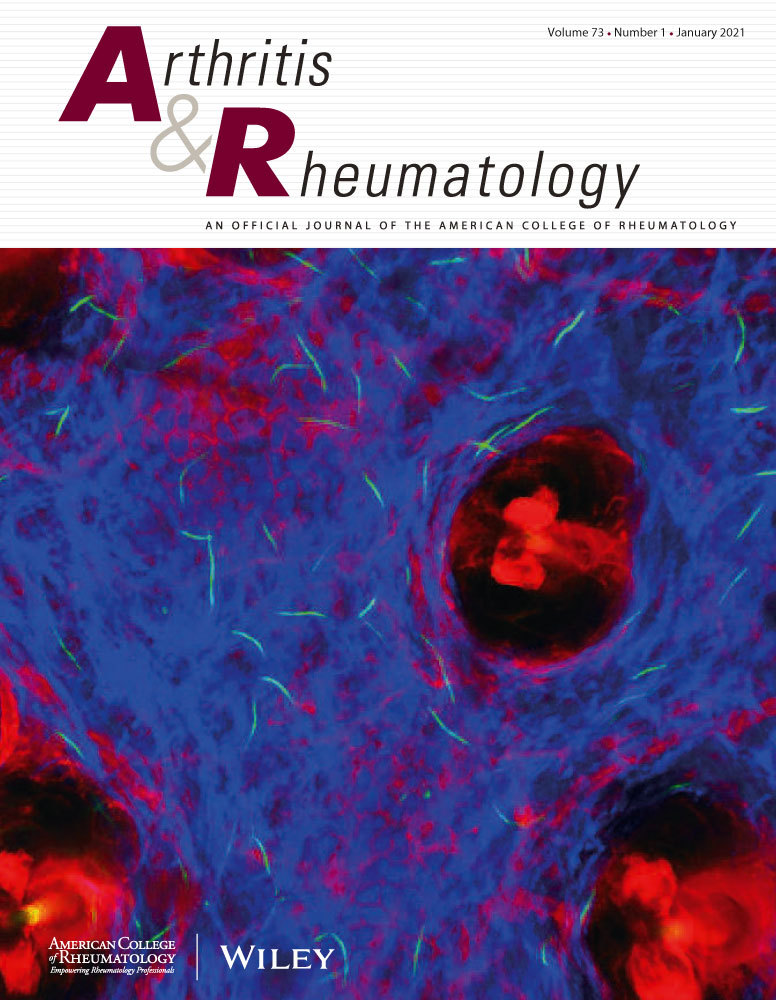Monocyte-derived macrophages-synovial fibroblasts crosstalk unravels oncostatin signaling network as a driver of synovitis in osteoarthritis.
IF 10.9
1区 医学
Q1 RHEUMATOLOGY
引用次数: 0
Abstract
OBJECTIVE Osteoarthritis (OA) is a debilitating joint disease characterized by cartilage degradation, synovial inflammation, and pain. Macrophages have been implicated in OA pathology, but the origins and functions of diverse macrophage subsets seeding the synovial joint tissue remain incompletely understood. This study investigates macrophage heterogeneity, ontogeny, fate, and communication with stromal niche cells in OA. METHODS Single-cell RNA sequencing was employed on synovial cells isolated from mice with collagenase-induced OA (CiOA) and CD14+ macrophages from four OA patients. We combined flow cytometry, genetic fate mapping, and imaging mass cytometry to profile synovial macrophage subsets. Cell-cell communication analyses were performed to investigate interactions cellular networks. RESULTS Three macrophage subsets with distinct gene signatures and origins were identified in CiOA, including contributions to synovial inflammation and tissue remodeling. Fate mapping via CCR2-creER and CX3CR1-creER mice revealed the expansion of monocyte-derived TIM4- MHCIIlow/high macrophages. Monocyte-independent TIM4+ CX3CR1+ macrophages operated a synovial niche shift, migrating near vascularized structures in the synovial sub-intima. Notably, the OSM/OSMR signaling network emerged as a critical pathway linking recruited CCR2-derived macrophages to fibroblast activation. In individuals with OA, single-cell transcriptomics identified a conserved MertKlow CD48high CCR2pos macrophage subpopulation as a key source of OSM. CONCLUSION Our study provides insights into macrophage subsets and their interplay with the joint microenvironment, bridging the gap between their origins, transcriptomic profiles, and roles in OA. Specifically, the OSM/OSMR axis represents a pivotal mechanism in recruited macrophage-fibroblast crosstalk, offering potential targets for novel biomarkers and therapies to manage OA-related synovitis.单核细胞来源的巨噬细胞-滑膜成纤维细胞的串扰揭示了骨关节炎滑膜炎驱动的肿瘤抑制素信号网络。
目的:骨关节炎(OA)是一种以软骨退化、滑膜炎症和疼痛为特征的衰弱性关节疾病。巨噬细胞与OA病理有关,但各种巨噬细胞亚群在滑膜关节组织中的起源和功能仍不完全清楚。本研究探讨OA中巨噬细胞的异质性、个体发生、命运和与基质生态位细胞的通讯。方法采用单细胞RNA测序方法对4例OA患者的CD14+巨噬细胞和胶原酶诱导OA小鼠的滑膜细胞进行分离。我们结合流式细胞术、遗传命运图谱和成像细胞术来分析滑膜巨噬细胞亚群。进行细胞间通讯分析以研究细胞网络的相互作用。结果在CiOA中发现了三种巨噬细胞亚群,它们具有不同的基因特征和起源,包括滑膜炎症和组织重塑。CCR2-creER和CX3CR1-creER小鼠的命运图谱显示单核细胞来源的TIM4- MHCIIlow/高巨噬细胞的扩增。单核细胞不依赖的TIM4+ CX3CR1+巨噬细胞进行滑膜生态位移位,在滑膜内膜下血管化结构附近迁移。值得注意的是,OSM/OSMR信号网络是连接募集的ccr2来源的巨噬细胞与成纤维细胞激活的关键途径。在OA患者中,单细胞转录组学鉴定出保守的MertKlow cd48高CCR2pos巨噬细胞亚群是OSM的关键来源。我们的研究提供了巨噬细胞亚群及其与关节微环境相互作用的见解,弥合了它们的起源、转录组谱和在OA中的作用之间的差距。具体来说,OSM/OSMR轴代表了募集巨噬细胞-成纤维细胞串音的关键机制,为治疗oa相关滑膜炎提供了新的生物标志物和疗法的潜在靶点。
本文章由计算机程序翻译,如有差异,请以英文原文为准。
求助全文
约1分钟内获得全文
求助全文
来源期刊

Arthritis & Rheumatology
RHEUMATOLOGY-
CiteScore
20.90
自引率
3.00%
发文量
371
期刊介绍:
Arthritis & Rheumatology is the official journal of the American College of Rheumatology and focuses on the natural history, pathophysiology, treatment, and outcome of rheumatic diseases. It is a peer-reviewed publication that aims to provide the highest quality basic and clinical research in this field. The journal covers a wide range of investigative areas and also includes review articles, editorials, and educational material for researchers and clinicians. Being recognized as a leading research journal in rheumatology, Arthritis & Rheumatology serves the global community of rheumatology investigators and clinicians.
 求助内容:
求助内容: 应助结果提醒方式:
应助结果提醒方式:


